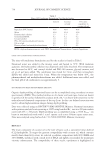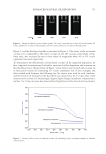745 INFLUENCE OF ETHNICITY AND DAMAGE LEVELS Substantivity calculation. FRM substantivity was calculated using Equation 1. Substantivity(%) Std weight FRM peak area Std peak area RF * * = * *100 FRMweight Equation 1 RESULTS AND DISCUSSION HAIR DAMAGE ASSESSMENT The results obtained for the damage characterization of hair tresses are summarized in Table III. In the comparison among the spectra obtained for virgin hair, the most important differences were observed in hair tresses that were straightened plus bleached for all the evaluated ethnicities. For these samples, hair oxidation caused by the oxidative agents present in this type of treatment was evidenced by the increased intensity of the band centered at 1,043 cm−1 (assigned to −S=O symmetric stretch), and the widening of the band at 1,177–1,233 cm−1 (characteristic of sulfonate and thiosulfate groups and portions of cysteic acid) (9–11). From the stress–strain curves obtained in the tensile test, we evaluated two important parameters: elastic modulus and break stress. In general, straightening followed by thermal damage was the process that generated the most severe changes in hair structure. However, all the evaluated damage processes resulted in an increase in the hair elastic modulus and a decrease in the break stress, thereby increasing its stiffness and fragility in comparison to virgin hair. For all evaluated ethnicities, the straightened and thermally damaged hair lost the highest amount of protein among the damage groups. As expected, virgin hair showed extremely low values of protein loss, which was statistically smaller than those of the other groups in all three ethnicities. Table III Summary of Damage Characterization Results Damage group Ethnicity FTIR–ATR Tensile Protein loss (mg/g of hair) Swelling (%) elastic modulus (MPa) Break stress (MPa) Straightened African No alteration +6%*** −7%*** +740%*** +38%*** Asian No alteration +4%* −3%* +1,059%*** +39%*** Caucasian No alteration +12%*** −5%*** +967%*** +35%** Straightened + thermally damaged African No alteration +31%*** −12%*** +1,851%*** −19%* Asian No alteration +29%*** −6%*** +2,651%*** −43%*** Caucasian No alteration +37%*** −2% +2,500%*** −35%*** Straightened + bleached African Oxidation +28%*** −4%* +920%*** +120%*** Asian Oxidation +27%*** −4%** +1,068%*** +161%*** Caucasian Oxidation +30%*** −3%* +736%*** +99%*** ***p 0.001, **p 0.01, and *p 0.05 versus virgin hair from same ethnicity.
746 JOURNAL OF COSMETIC SCIENCE The swelling test results made it possible to gain a better understanding of the variation in hair fiber permeability to water after the different damage processes. The greatest variations in the fiber diameter occurred immediately after immersion in water, especially in the first minute of the test. After 120 s under water, a plateau formation was observed in the swelling curves, with the exception of the ones taken from the straightened and thermally damaged hairs. In this case, the percentage of diameter change grew almost linearly with time (Figure 1), possibly indicating that the swelling process continued even after 200 s and that these hair fibers may present higher values of diameter variation after long periods of water immersion. The profiles observed for the different damage groups were highly similar when comparing different ethnicities. After 200 s, the tresses that were straightened and straightened and bleached exhibited statistically larger diameter variations than those observed for the virgin hair. This increase may be related to the internal and external changes in these fibers caused by chemical treatments, such as lipid and protein oxidation and cuticle lixiviation (12,13), which results in a decrease in hair hydrophobicity and an increase in its water permeability. The straightened and bleached hair group presented the largest increase in fiber diameter after this period, exhibiting a water permeability that was at least twice as high as that observed for virgin hair. However, the hair fibers that were subjected to straightening followed by thermal damage showed decreased swelling rates and final diameter variations (during the evaluation period) compared with the virgin fibers. This fact may be correlated with the fusion of the cuticles that may occur after strong thermal processes (14), which can decrease the water permeability of these fibers by occluding the water entrance paths. The damage caused by the different procedures was also evident in the SEM images (Figure 2), where cuticle lixiviation, fractures, holes, and exposed cortex were observed these observations are in accordance with the results obtained from the instrumental tests detailed above. FRAGRANCE SUBSTANTIVITY TEST The substantivities of the five chosen FRMs were evaluated for wet (T0) and dry hairs (T24 h). From the general results (Table IV), it was observed that there was a difference in the substantivity values of wet and dry hairs, with greater substantivity values obtained for wet hair as compared to dry hair. Since FRMs are small and volatile compounds, it was expected that a portion of the initial amount of fragrance retained on the wet substrate would be lost to the environment during the drying process. Polarity also influenced FRM elimination, with the most polar substances being dragged by the water during the drying process, thus exhibiting large differences in substantivities of wet and dry hairs. The greatest decays in absolute FRM substantivity values of wet and dry conditions were observed for sulfurol, and the smallest decays were observed for gamma undecalactone (Table V). Among the tested FRMs, sulfurol was the most volatile and the most polar substance, which explains why it was eliminated during the drying process. In contrast, gamma undecalactone presented lower volatility and polarity than sulfurol, showing better retention (or a long-lasting effect) on hair fibers. Among the FRMs, sulfurol presented the highest substantivity on hair fibers. An exception to this behavior was in the group of hairs that were straightened and bleached in dry conditions.
Purchased for the exclusive use of nofirst nolast (unknown) From: SCC Media Library & Resource Center (library.scconline.org)






































































































































